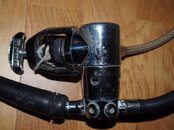elan
Contributor
I dove an MK5 with S600 yesterday in 39F - no issues. The S600 has an upgraded metal barrel.
Welcome to ScubaBoard, the world's largest scuba diving community. Registration is not required to read the forums, but we encourage you to join. Joining has its benefits and enables you to participate in the discussions.
Benefits of registering include
I get particually irrate by those reccomending regulators who consider 40 degrees cold. I have dove many Oceanic regs and took my SR1 out yesterday for a dive. Air temp in the low 20's water 34. The failure rate increased logrythmically as you approach the freezing point of the water you are diving in. All of the free flows I have expirenced are second stage orientated. Environmentally sealed diaphragm 1st stages are most immune to failure but as I said most failures are 2nda stages.
My SR1 free flowed twice on the dive. Both times I switched to my old posiedon which gave me no problem. The acid test is switching to a floodedl reg that is anything but dry. Another diver with a SR1 also free flowed. Since he only had a single tank so his dive was over. Under water I switched back to the SR1 only to have it free flow again. So I turned off its tank and 5 min latter pressured it back up and it had melted, I stayed with the posiedon through the rest of the dive. Similar things have happened with a bunch of Oceaics. The most reliable were their servo valve Zeta and Omega 2nds. I have never had my Oceanic 1st stage fail or the Sherwood. I've seen unsealed Cressie's that say they are cold water. COLD is relative and there is no way an unsealed reg is cold water.
!
I think that some blame for the second stage failures is due to the change in dynamics of various springs at low temps so I am going to detune both SR1's and see what happens on our next dive. Blizzards have fewer springs, metal strips that warm the seat assembly from your exhaled breath and do not breathe as easy. The more springs you have the harder it is to make a RELIABLE ice reg IMHO.
Done for now...I will edit my post latter to finish my thoughts.


